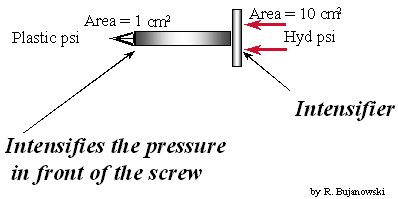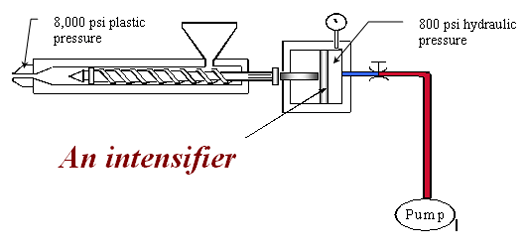In all hydraulic injection units, hydraulic power is converted, multiplied, into plastic pressure. The law of physics involved is F = P x A. That is force (F) is equal to pressure (P) times area (A). The large hydraulic piston acts on the screw, or essentially the non-return valve. The hydraulic piston has a large surface area, for example 100 cm2. The non-return valve during injection forward acts like a smaller area piston, for example 10 cm2. This causes the hydraulic pressure to be converted to melt or plastic pressure in the barrel of the injection unit.
In this specific case hydraulic pressure is “intensified” or multiplied by a factor of 10. That is 800 psi of hydraulic pressure provides ~8,000 psi of melt pressure inside the nozzle of our machine. Often this is called the machine’s intensification ratio and explains how hydraulic pressure can provide tens of thousands of psi plastic pressure inside the nozzle. Today you can buy machines with intensification ratios ranging from 6:1 to 43:1.
All machines are NOT 10:1. It is plastic pressure that pushes plastic into the sprue, runner, gate and mold cavity, NOT hydraulic pressure. If your plant has different machines, most likely they have different intensification ratios. That is 800 psi pack and hold pressure on one machine with an intensification of 10:1 may be packing out the part with 8,000 psi plastic pressure, but on another machine with a different intensification ratio of 12.75:1; 800 psi hydraulic pressure may be 10,200 psi plastic packing pressure in the nozzle. You will not make the same part, sorry!
Recording and determining intensificatoin ratios for all of the machines in your operation can be a tedious and time-consuming process.
Figure 1 & 2, provide illustrations:
![]()

![]()

About the Author
| John Bozzelli Injection Molding (IM) Solutions 1019 Balfour St. Midland, MI 48640-3227 Phone: 989-832-2424 Fax 989-832-8743 Email: john@scientificmolding.com www.ScientificMolding.com |
John Bozzelli is a graduate of Marietta College (BS) and Ohio University (MS). His studies were interrupted for a stint in Vietnam (US Army, Purple Heart; Silver Star). Twenty years in Dow Plastics provided extensive experience in polymer synthesis, development, production, and processing. John has been a seminar leader with RJG Associates, Injection Molding Magazine, University of Wisconsin Milwaukee, General Polymers and John Klees. Competent in resin characterization and analysis, his specialty is practical, hands-on injection molding training with both small and large machines. National recognition has come through ten patents, over 60 papers covering plastics, processing, machine specifications, and over 12 years on the national seminar circuit. Feature articles such as the “Productivity”; by Plastics World and ”Scientific Molding” by Injection Molding Magazine October, November and December 1997, have highlighted a couple of exemplar case histories. Check out the August 2001 issue for applications of The Universal Set Up Sheet.John is the initiator of Scientific Injection Molding and teaches the plastic’s point of view for design and processing with a passion you will remember. Take some of your valuable time to learn practical molding techniques that improve your profits tomorrow while eliminating the state of ”fire fighting“ currently found in many molding facilities. Let us keep plastic manufacturing strong in North America. |
The views, opinions and technical analyses presented here are those of the author or advertiser, and are not necessarily those of ULProspector.com or UL Solutions. The appearance of this content in the UL Prospector Knowledge Center does not constitute an endorsement by UL Solutions or its affiliates.
All content is subject to copyright and may not be reproduced without prior authorization from UL Solutions or the content author.
The content has been made available for informational and educational purposes only. While the editors of this site may verify the accuracy of its content from time to time, we assume no responsibility for errors made by the author, editorial staff or any other contributor.
UL Solutions does not make any representations or warranties with respect to the accuracy, applicability, fitness or completeness of the content. UL Solutions does not warrant the performance, effectiveness or applicability of sites listed or linked to in any content.


